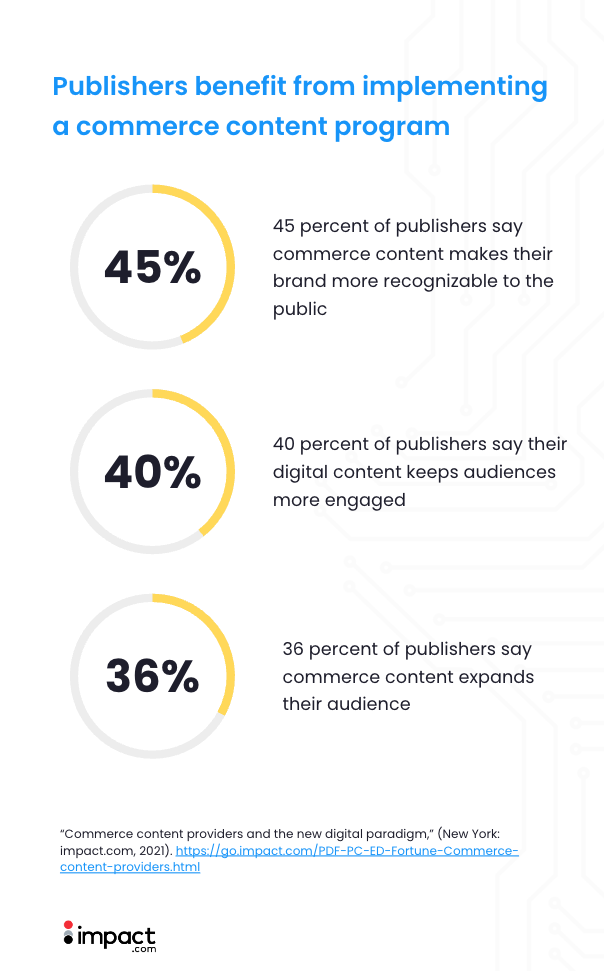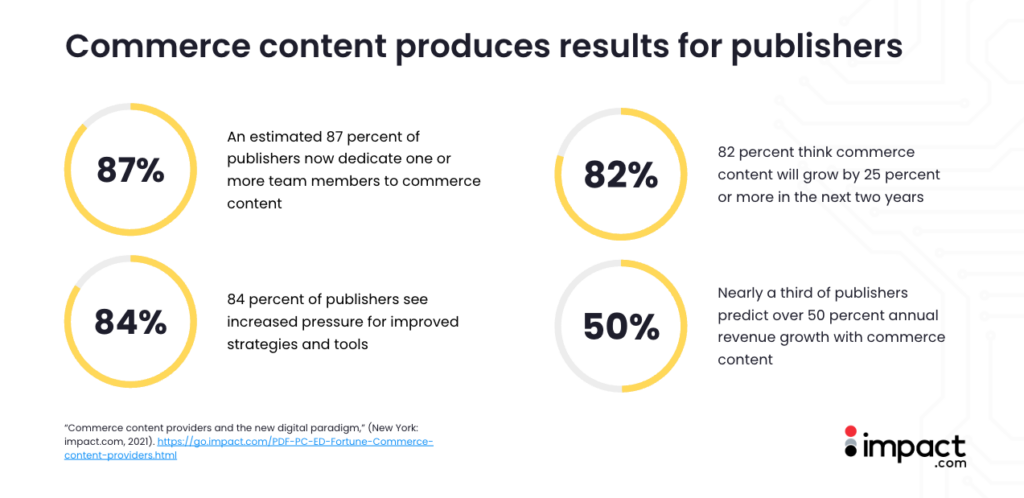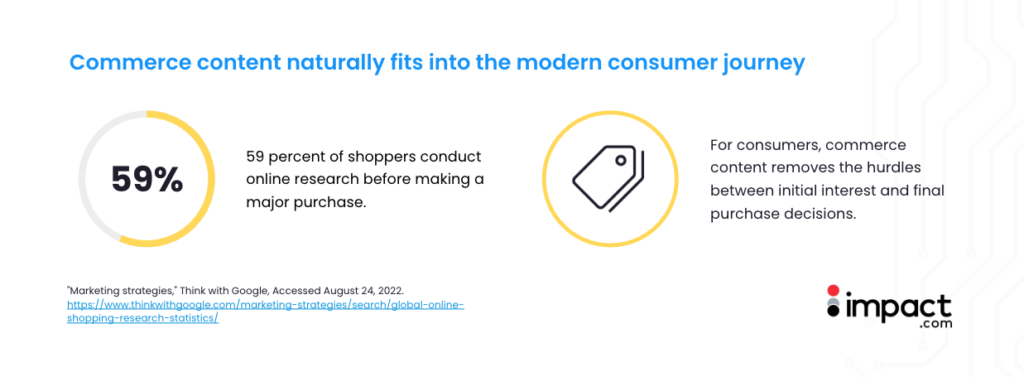Commerce content—a promising new initiative for many publishers—presents another primary revenue channel alongside paywalls, advertising, and events.
With commerce content, consumers discover products through the creators and sources they already follow and enjoy. This type of content—which comes in many forms like videos, blogs, and articles—isn’t just a promotional vehicle. It also provides people with helpful information and entertainment value.
As a publisher, you want to keep up with the times, and commerce content opens up new territory. There couldn’t be a better moment to learn more about the commerce content maturity model and increase your chances of developing a successful strategy.

Ultimate guide to commerce content maturity
Take this helpful information with you. Download The ultimate guide to commerce content maturity.
Learn moreWhat do consumers look for when shopping online?
One out of every four people in the world shops online. This trend only continues to grow. The COVID-19 pandemic increased online shopping by 25 percent over a single year.
Before making a purchase online, consumers want access to reliable information. They can find countless options for any product at their fingertips. Understandably, consumers look for genuine recommendations and user reviews when they shop. To meet this need, successful brands partner with publishers to educate, entertain, and promote products.
For consumers, publisher recommendations carry more weight than traditional ads. Good content creators build credibility on specific topics. Audiences seek out (and sometimes stumble upon) these trusted sources when researching topics or recommendations on platforms like YouTube, Instagram, and Facebook.
For example, if you see a recommendation for a new cooking pan on your favorite food blog, you’re more likely to purchase it than if you come across it on a random banner ad. The same goes for most other products and services—from electronics to clothing to investment apps.
Cultivating consumer trust through partnerships
Most publishers today recognize the importance of cultivating consumer trust. When consumers read a helpful piece of commerce content that doesn’t feel like a blatant ad, they feel better equipped to make a purchase. For example, a buyer’s guide offers real-world use cases for a product that the consumer can reference before purchasing.
Consumers respond to value-added content and publishers see indirect benefits right away.

Product recommendations naturally fit into your existing content. You choose which brands to partner with and maintain editorial integrity while earning commissions. As your audience derives value from this content, you gain a larger following and drive more revenue, which benefits you and your partner brands. It’s a win-win for everyone involved in the customer journey.
Why grow a commerce content program?
Investing in commerce content pays off. Digital publishers saw more than a 30 percent increase in total revenue, cash flow, and profit margins.

It’s no surprise that the publishing industry is optimistic about the future of this approach. Commerce content offers clear advantages for online creators and publishers.
Diversify income streams without intermediaries
Ads don’t generate the same revenue they once did. Google and Facebook contributed to 90 percent of global digital advertising revenue growth, leaving little market share for publishers.1 On top of this increased competition, some advertisers also cut back on ad spending during the pandemic.
Commerce content sidesteps the need for third-party advertising brokers and supports publisher expansion. With these types of partnerships, you gain stability against the shift in online trends and purchase models.
Content partnerships also create diversified income streams that help you avoid risk. While paywalls and traditional ads still work for some publishers, commerce content provides additional flexibility. Integrated recommendations work with every form of media, from long informational blogs to short social media posts and podcasts.
Create an unintrusive user experience
A positive user experience drives consumers to return to your website. Commerce content creates a better experience by doing away with intrusive ads and empowering consumers to take charge of their purchase journey.
You can inject commerce content into any stage of the consumer journey. A few examples you can use during the various stages include:
- New product launch (awareness stage)
- How-tos (education stage)
- Buyer’s guides (consideration stage)
- Reviews (validation stage)
Invest in a consistent brand marketing channel
The financial risk for brands remains low with commerce content, making it a consistently attractive option compared to ads. Instead of investing large marketing budgets upfront, commission payments go out with each click or purchase. Brands then track the money spent on marketing through these partnerships alongside actual sales traffic.
Brands also regularly experiment with different partners thanks to the low risk of commerce content. This gives publishers more opportunity to forge new, lucrative partnerships.
Brands constantly look for new ways to find audiences with a built-in interest in their products, and publishers can reach out to companies that fit their style and values. Successful publishers may also develop dedicated commerce editor roles, directly seek out brands, and build strong partnerships.
Adopt a business model that benefits everyone
Commerce content brings together online purchase intent and information consumers seek and enjoy. Publishers make a living through partnerships and shoppable content, yet still maintain their voice and independence.

The essential components of commerce content
Before you establish and scale a commerce content program, you need to understand how it works. Publishers accelerate program efficiency and effectiveness by optimizing these core components of their content.
Let’s look at two of the most important aspects of commerce content: Affiliate partnerships and revenue attribution.
1. Affiliate partnerships
Affiliate partnerships play a huge part in commerce content. These partnerships form in a variety of ways:
- Brands looking for a new, untapped audience seek publishers with compatible content and values.
- On the other hand, publishers can reach out to brands as they try to increase and diversify their revenue.
Finding the right brand partner is imperative. If a publisher genuinely appreciates a particular product, an affiliate partnership with a brand benefits everyone involved. Remember: customers easily spot forced recommendations, which turns them away.
At the start of an affiliate partnership, the publisher and brand decide its structure. Generally, the structure tends to follow one of two formats:
- A purchase triggers a commission payment
- Affiliate publishers receive payment as consumers follow links to the brand’s website and make a purchase
Affiliate software platforms streamline this process by tracking metrics, sales, commissions, and more.
Affiliate link options
Publishers most commonly monetize content with affiliate links, referring consumers to specific recommended items within the text of the content. For example, a publisher creates a holiday gift guide and adds hyperlinks to each brand’s ecommerce store in its article or video description.
Some publishers use affiliate software to follow website traffic and purchases made through each link. This allows them to track each content partner’s expected commission.
2. Revenue attribution
When publishers partner directly with brands, they can quickly identify the consumer’s path to conversion. But the consumer’s path often involves multiple touchpoints. Commerce content revenue attribution helps publishers understand the consumer journey and the many channels involved in that path.
For example, if a customer interacts with a brand’s digital channels multiple times before making a purchase, there are various ways to provide the publisher (partner) with credit or value. Digital channels include email, social media, referrals, and recommendation links. This situation arises often for publishers that have a robust content amplification strategy in place.
Publisher attribution usually ties to paid marketing that drives traffic to their commerce content page—and ultimately to a brand’s ecommerce website. At this stage, publishers may lose sight of the traffic, even if they know what commission they receive from a brand.
How software assists with revenue attribution
Publishers can use software like Trackonomics by impact.com—part of the impact.com for Publishers suite—to gain a complete view of the customer journey. The Funnel Relay feature allows you to measure return on investment (ROI) and connect traffic acquisition channels for funnel content revenue attribution.
The Funnel Relay feature shows publishers:
- How a user found their website
- Where the user landed
- Where they went
- When they made a purchase
Revenue attribution software closes the gap between inbound traffic to publishers and advertiser sales. Funnel Relay also links the cost of traffic to ROI and allows publishers to optimize traffic acquisition based on actual sales performance. Traffic acquisition includes organic (and free, like email or organic social) or paid (like a social channel).
Some brands reward partners that provide the last touch before purchase, while others base commission on the first interaction. The commission could also track time to purchase—with payments increasing as interactions come closer to purchase. In a nutshell, revenue attribution changes based on your needs and offers customizable setups and options.
The six stages of commerce content maturity
Most publishers don’t stand up successful commerce content programs overnight—it’s an iterative process with distinct stages.
To make your commerce content program the best it can be, you need to progress through six stages.

When you understand each stage of the maturation process, you know exactly how to maximize your program’s effectiveness. Publishers often use software to streamline, scale, and monetize faster.
Discover which stage of the content maturation process you currently sit in and how to take your program to the next level.
Stage one: The unaware publisher
Publishers just starting out or struggling to increase revenue often fit into this stage. They may be unaware or misinformed about the potential power of commerce content.
If you’re in the unaware stage, you may rely on low-paying generic ads and subscription models for revenue. You may also lean on paywalls, which restrict your potential reach, especially if you have yet to establish an audience or reputation. As privacy regulations shift, selling and tracking consumer data offers fewer revenue opportunities.
Consumer buying habits have changed since 2020. Online marketing and sales don’t remain static for long. As online commerce and marketing continue to shift, publishers without diversified income streams struggle. They also miss out on the superpower of commerce content: bringing in interested customers and higher revenue.
Why is content about products popular?
Online audiences often need recommendations for products and services—just look at the massive success of review channels, blogs, and comparison websites.
Consumers seek out expertise and experience when they do online research. To meet this demand, many publishers promote and create:
- Gift guides
- How-to articles
- Hands-on tests
- Reviews
Ideally, commerce content gives consumers valuable and entertaining information while building a relationship between publishers and readers/viewers. Honesty and nuance encourage audience trust and build publisher integrity.
Commerce content without partnerships
Many publishers create commerce content because it‘s popular with audiences and brings consistent engagement. But those that don’t use partnerships to monetize their commerce content recommendations essentially send traffic to brand websites for free.
Once you begin to harness the power of commerce content partnerships, they quickly become a core revenue source.

Stage two: Experimentation requirements
Commerce content offers an attractive supplement (and sometimes alternative) to the two pillars of traditional publishing: advertising and subscription revenue.
But you may feel unsure about relying on commerce content as a central revenue channel. You might worry about audience pushback and losing editorial integrity. You also need to partner with products and brands that fit your values.
This stage requires experimentation. Explore your audience’s reactions to the content and what they respond most to. You’ll see conversion rates quickly grow when you partner with the right brands.
If your content fits a niche market or topic, you have a great starting point for a commerce content program. Your baseline understanding of your audience’s interests puts you at an advantage.
Understanding your audience
At this stage, testing how commerce content generates revenue is a top priority.
- Research and analyze data that may affect your commerce content going forward.
- Test your post and video click-through rates to gauge audience interest.
- Track how people find you.
- Follow and record online traffic. This data guides you on how best to move forward.
Metrics provide better positioning knowledge. Get to know your top referral sources and discovery routes using UTM tracking. This knowledge puts you in your audience’s shoes and generates actionable data.
In short, you must understand the consumer’s journey on your website to find the path to profitablity.
Affiliate networks provide a starting point
Affiliate networks and the Amazon Associates program provide a springboard to experiment with creating affiliate links for different content and products. In their simplest form, affiliate networks connect publishers with brands on a single platform. From there, you can immediately monetize content.
Many publishers first look to Amazon as an affiliate network since it’s easy to find almost any product. But this translates to missed opportunities for publishers.
Broaden your opportunities and look for brands that negotiate better rates than Amazon. Join multiple affiliate networks to expand your access to numerous types of commissions and brands.
Use the experimentation phase to learn your audience and test your partnerships. You may hit some speed bumps along the way, but that’s okay. As you build your commerce content catalog, use data to validate your findings along the way.
Data analysis offers valuable strategic insights
Data about your consumer’s journey offers nearly endless opportunities to optimize your program. However, certain hurdles may still exist during the experimentation stage:
- Data requires time-consuming analysis to gain actionable insights
- Data split across various platforms makes it difficult to manually consolidate and analyze
- Consolidation and analysis mistakes delay progress or cost valuable resources
Manually gathering and tracking data falls short compared to automated software. But you can call on the right tools to streamline your process and understand your audience at a granular level.
What to look for in a data management platform
The best data management platforms enable complete and comprehensive affiliate program insights by gathering data sources into a single interface.
For example, a platform like Trackonomics by impact.com—part of the impact.com for Publishers suite—offers a solution to oversee commerce content operations. You get page-level insights, a dashboard, optimization tips, and more. Your data now drives new affiliate relationships and grows revenue.

Stage three: Validate your offer
Once you gather audience metrics and test your affiliate partnerships, validation comes next.
At this stage, ask:
- Are the data interpretations accurate?
- Which content works well?
- What are the conversion and click-through rates?
Once you build a catalog of published commerce content, real-world information can confirm (or redirect) your initial plans. Instead of going through these stages on a strict schedule, get comfortable with your level of testing and experience before continuing to scale.
You’ll find out what works when you assess which content and recommendations create revenue. Conversion and commissions must be reliable and replicable before you ramp up the volume of content production.
What counts as validation?
Validation means something different to each publisher. Once you create content and develop your catalog, deconstruct the data and analyze demand.
Set basic success metrics to start, then customize based on your situation or model. Think about these questions:
- Does your audience respond to the call to action?
- Has traffic increased?
- Did you earn new subscribers and repeat readers?
- Did page bounce rates decrease?
- Are conversion rates higher?
Once you identify preliminary metrics, use the data to make decisions about your commerce content plan. For example, if your buyer’s guides drive more high-intent consumers to your brand partner’s website than review videos, consider creating more buyer’s guides. Alternatively, dig further into the data and determine why your review videos aren’t as popular.

Stage four: Scale your program
You’ve built your plan and hypothesis, tested your model, and validated it with accurate data. Now focus on scaling and determining growth.
First, build out multinetwork expansions. These connections open the field, allowing publishers to work and partner with many more brands.
Double down on valuable content
Now that you fine-tuned content for your audience, focus on what best fits your niche and raises conversion rates. Valuable content educates and inspires readers. Your content has the longest possible shelf life if it solves a specific problem or answers common questions for your audience.
Evergreen content doesn’t disappear or fade away when trends shift. Actionable content remains relevant for the long term and builds valuable Google equity for your domain and integrated affiliate links.
Invest in search engine optimization
Search engine optimization (SEO) drives consumers to your page.
Publishers must perform SEO research to compete and scale. For example, if your post about eye creams generated traffic and conversions, conduct SEO keyword research based on the “eye creams” keyword for your next post.
Your team can better understand your audience and potential readers when you identify high-performing keywords. SEO research also provides information about your competition. Using data on competing publishers, assess keyword gaps to create successful content and stand out in oversaturated markets. Your editorial team can track week-over-week differentials in success metrics and measure scaling efforts.
Long-term success and expansion come from building a solid consumer knowledge base. When you effectively track your data, you establish a thriving foundation to scale.

Stage five: Optimize revenue channels
Now, focus on optimizing revenue. Drill down into data that matters to you and repeat successful elements from previous phases.
As an established publisher, you can directly negotiate hybrid deals across strategic partners. Focus on affiliate partnerships that provide the best return on your recommendations and integrations.
Take this opportunity to refine your publication’s positioning in the market and make your program as lucrative as possible.
Foster strategic partnerships
As your program grows, you gain more opportunities to forge brand partnerships. With an expanded content library and increased traffic, your audience becomes highly valuable—making you a more appealing partner.
Foster mutually beneficial relationships that increase incremental value for both parties. When both publishers and brands benefit, you create a solid base for a long-lasting partnership.
Consolidate siloed media buying data
Many publishers buy paid or organic social media to drive their followers to commerce content. In this case, followers click out to a merchant and make a purchase.
While this can effectively drive sales, you lose insight into campaign performance when you silo media-buying data from affiliate data. Since you’ve optimized your affiliate data by this stage, do the same for your media-buying data.
Many publishers look to affiliate platforms to remove silos. The result? Better program visibility.
Maximize the life of your affiliate links
One of the most common pitfalls that more mature commerce content programs is link rot. This is when an affiliate link pushes a user to an out of stock product or 404 error. Stay on top of this issue by developing a robust link rot prevention strategy or implementing an automated solution. This helps you maintain your reader experience while recouping lost revenue.
Stage six: Grow your audience
In the final stage of the commerce content maturity process, you focus primarily on growth. Driving more traffic to your content increases your audience size, providing the opportunity to make more revenue.
You may choose to syndicate (republish) content to new audiences by leveraging partnerships and research.
- Syndication may happen organically if you share content to websites like Reddit, Pinterest, or LinkedIn, for example.
- Paid options like Outbrain or Taboola and news aggregator websites such as Flipboard or SmartNews can also help spread your content.
As you follow and record traffic with a platform, you’ll notice areas for improvement and solutions for growth.
Diversify distribution pathways
As your content scales, form actionable and authentic marketing strategies to build awareness, increase traffic, and drive conversions. Find simple ways to boost your content’s visibility first, then focus on larger-scale plans.
Try methods like direct traffic through social media accounts, email marketing, and pay-per-click campaigns. With these campaigns, publishers pay a small fee for each click on a post or ad.
Widen your focus and aim for diverse distribution methods to increase traffic and profits.

Future-proof your business with commerce content
Commerce content opportunities show no signs of slowing. As privacy laws change, affiliate publisher recommendations and links embedded in high-quality content have an even higher value. When Google and Facebook monopolize automated ad exchanges, publishers and brands urgently need options like commerce content to reach consumers.
Commerce content offers flexible and direct access to the right audiences. Publishers win half the marketing battle when consumers show interest in their content. They also build trusting relationships with audiences.
Scaling and optimizing your commerce content program allows you to stay one step ahead of your audience’s expectations and your brand partners’ needs. By following a structured commerce content maturation model, you maximize the wide variety of benefits commerce content offers.

Ultimate guide to commerce content maturity
Take this helpful information with you. Download The ultimate guide to commerce content maturity.
Get your free guideUse automation to grow your commerce content program
Clean, transparent, and actionable ecommerce data is good data. As part of the impact.com for Publishers suite, Trackonomics by impact.com helps publishers leverage data to maximize partnerships. Drive commerce content success with the only supply-side data management platform on the market. Enable maximum scalability through data consolidation, automation, and holistic affiliate program insights.




